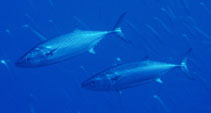把你的觀察加入 Fish Watcher
| Native range | All suitable habitat | Point map | Year 2050 |

|
| This map was computer-generated and has not yet been reviewed. |
| Sarda sarda AquaMaps Data sources: GBIF OBIS |
Common names from other countries
分類 / Names 俗名 | 同種異名 | Catalog of Fishes(屬, 種) | ITIS | CoL | WoRMS | Cloffa
Teleostei > Scombriformes (Mackerels) 鱸形目 (Mackerels) > Scombridae (Mackerels, tunas, bonitos) 鯖科 (Mackerels, tunas, bonitos) > Scombrinae
Etymology: Sarda: Latin and Greek, sarda = sardine; name related to the island of Sardinia (Ref. 45335).
More on author: Bloch.
Etymology: Sarda: Latin and Greek, sarda = sardine; name related to the island of Sardinia (Ref. 45335).
More on author: Bloch.
Environment: milieu / climate zone / depth range / distribution range 生態學
海洋; 半鹹淡水; 海洋洄游的 (Ref. 51243); 深度上下限 80 - 200 m (Ref. 5377). 亞熱帶的; 12°C - 27°C (Ref. 168); 62°N - 40°S, 98°W - 42°E (Ref. 54865)
分布 國家 | FAO區域 | 生態系 | 發現紀錄 | Point map | 簡介 | Faunafri
Eastern Atlantic: Oslo, Norway to Port Elizabeth, South Africa. Also known from the Mediterranean and Black Sea. Western Atlantic: Nova Scotia, Canada to Florida, USA and northern Gulf of Mexico; then from Colombia, Venezuela, and south of the Amazon River to northern Argentina; apparently absent from most of the Caribbean Sea.
東大西洋: 奧斯陸,挪威到南非的伊莉莎白港。 也已知來自地中海與黑海。 西大西洋: 到美國的佛羅里達與墨西哥灣北部的加拿大的新斯科舍省; 然後從亞馬遜河到阿根廷北部哥倫比亞,委內瑞拉與南方; 顯然地大部分的加勒比海沒有出現。
東大西洋: 奧斯陸,挪威到南非的伊莉莎白港。 也已知來自地中海與黑海。 西大西洋: 到美國的佛羅里達與墨西哥灣北部的加拿大的新斯科舍省; 然後從亞馬遜河到阿根廷北部哥倫比亞,委內瑞拉與南方; 顯然地大部分的加勒比海沒有出現。
Length at first maturity / 大小 / 重量 / 年齡
Maturity: Lm 37.8, range 41 - ? cm
Max length : 91.4 cm FL 雄魚/尚未辨別雌雄; (Ref. 168); common length : 50.0 cm FL 雄魚/尚未辨別雌雄; (Ref. 168); 最大體重: 11.0 kg (Ref. 40637); 最大年齡: 5 年 (Ref. 29114)
Max length : 91.4 cm FL 雄魚/尚未辨別雌雄; (Ref. 168); common length : 50.0 cm FL 雄魚/尚未辨別雌雄; (Ref. 168); 最大體重: 11.0 kg (Ref. 40637); 最大年齡: 5 年 (Ref. 29114)
簡短描述 檢索表 | 型態特徵 | 形態測量圖
背棘 (總數) : 20 - 23; 背的軟條 (總數) : 15 - 18; 臀棘: 0; 臀鰭軟條: 14 - 17; 脊椎骨: 50 - 55. Mouth moderately large. Laminae of olfactory rosette 21-39. Interpelvic process small and bifid. Body completely covered with very small scales posterior to the corselet. Swim bladder absent. Spleen large. Liver with elongate left and right lobe and short middle lobe. Oblique dorsal stripes with a greater angle than in other species of Sarda.
嘴普通大的。 嗅覺毛簇 21-39 的葉片. 腹鰭間的突起小而兩裂的。 身體完全地覆蓋著了最小鱗片在甲胄後面。 泳鰾不存在。 脾臟大的。 肝臟有細長的左邊與右邊的葉與短的中央葉。 斜的背部斑紋具有一個較大的角超過在其他種的 Sarda 中.
嘴普通大的。 嗅覺毛簇 21-39 的葉片. 腹鰭間的突起小而兩裂的。 身體完全地覆蓋著了最小鱗片在甲胄後面。 泳鰾不存在。 脾臟大的。 肝臟有細長的左邊與右邊的葉與短的中央葉。 斜的背部斑紋具有一個較大的角超過在其他種的 Sarda 中.
Epipelagic, neritic and schooling species that may enter estuaries. Known to be cannibalistic, adults prey on small schooling fishes, invertebrates like squid and shrimps and can swallow relatively large prey. Eggs and larvae pelagic (Ref. 6769). Utilized fresh, dried or salted, smoked, canned and frozen (Ref. 9987). Able to adapt to different temperatures 12° to 27°C and salinities 14 to 39 (Ref. 36731).
表層帶, 可能進入河口的淺海與群游性種。 已知是同類相食的, 成魚捕食小的群游性魚, 像烏賊與蝦一樣的無脊椎動物而且能吞相當大的獵物。 生鮮使用, 乾燥或鹽醃, 煙燻, 罐裝及冷凍.(參考文獻 9987) 能適應不同的溫度 12 對 27 °C 與鹽度的 ° 14 到 39.(參考文獻 36731)
表層帶, 可能進入河口的淺海與群游性種。 已知是同類相食的, 成魚捕食小的群游性魚, 像烏賊與蝦一樣的無脊椎動物而且能吞相當大的獵物。 生鮮使用, 乾燥或鹽醃, 煙燻, 罐裝及冷凍.(參考文獻 9987) 能適應不同的溫度 12 對 27 °C 與鹽度的 ° 14 到 39.(參考文獻 36731)
Life cycle and mating behavior 成熟度 | 繁殖 | 產卵場 | 卵 | 孕卵數 | 仔魚
東大西洋: 奧斯陸,挪威到南非的伊莉莎白港。 也已知來自地中海與黑海。 西大西洋: 到美國的佛羅里達與墨西哥灣北部的加拿大的新斯科舍省; 然後從亞馬遜河到阿根廷北部哥倫比亞,委內瑞拉與南方; 顯然地大部分的加勒比海沒有出現。
主要參考資料
Upload your references | 參考文獻 | 合作者 : Collette, Bruce B. | 合作者
Collette, B.B. and C.E. Nauen, 1983. FAO Species Catalogue. Vol. 2. Scombrids of the world. An annotated and illustrated catalogue of tunas, mackerels, bonitos and related species known to date. Rome: FAO. FAO Fish. Synop. 125(2):137 p. (Ref. 168)
人類使用
漁業: 高經濟性; 游釣魚種: 是的
FAO(漁業: 產生, 魚種描繪; publication : search) | FishSource | 周邊海洋
更多資訊
Population dynamics
成長參數
Max. ages / sizes
Length-weight rel.
Length-length rel.
長度-頻率
Mass conversion
入添量
豐度
成長參數
Max. ages / sizes
Length-weight rel.
Length-length rel.
長度-頻率
Mass conversion
入添量
豐度
Physiology
Body composition
Nutrients
耗氧量
游泳類型
游泳速度
Visual pigments
Fish sound
Diseases & Parasites
Toxicity (LC50s)
Body composition
Nutrients
耗氧量
游泳類型
游泳速度
Visual pigments
Fish sound
Diseases & Parasites
Toxicity (LC50s)
工具
Bio-Quiz | E-book | 野外調查 | 檢索表 | 長度- 頻率 Wizard | 生活- 歷史的工具 | 分布圖 | Classification Tree
| Catch-MSY |
特別的報告
下載 XML
網路資源
Aquatic Commons | BHL | Cloffa | BOLDSystems | Websites from users | 檢查 FishWatcher | CISTI | Catalog of Fishes(屬, 種) | DiscoverLife | DORIS | ECOTOX | Faunafri | Fishtrace | GenBank(基因組, 核甘) | GloBI | GOBASE | GoMexSI (interaction data) | | Google Books | Google Scholar | Google | IGFA World Record | MitoFish | 國家資料庫 | Otolith Atlas of Taiwan Fishes | 公眾的水族館 | PubMed | Reef Life Survey | Scirus | SeaLifeBase | 樹狀分類階層 | Wikipedia(去, 搜尋) | World Records Freshwater Fishing | 動物學的記錄
Estimates based on models
Preferred temperature (Ref. 115969): 7 - 23.4, mean 10.7 (based on 346 cells).
Phylogenetic diversity index (Ref. 82804): PD50 = 0.5312 [Uniqueness, from 0.5 = low to 2.0 = high].
Bayesian length-weight: a=0.00871 (0.00764 - 0.00993), b=3.06 (3.02 - 3.10), in cm Total Length, based on LWR estimates for this species (Ref. 93245).
營養階層 (Ref. 69278): 4.5 ±0.0 se; based on diet studies.
回復力 (Ref. 120179): 中等的, 族群倍增時間最少 1.4 - 4.4年 (K=0.13-0.24; tm=1; tmax=5).
Prior r = 0.57, 95% CL = 0.37 - 0.85, Based on 9 data-limited stock assessments.
Fishing Vulnerability (Ref. 59153): Low to moderate vulnerability (33 of 100).
Climate Vulnerability (Ref. 125649): Moderate to high vulnerability (48 of 100).




